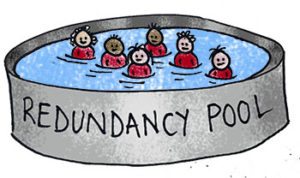Once an organisation has decided to make redundancies and selected which employees it is putting ‘at risk’ of redundancy minds must be turned to which employees will be selected.
Key requirements for Redundancy Selection Criteria
- At the outset of the process no one individual should be more at risk of redundancy than any other;
- The employer must not rely on the subjective judgement of the person making the assessment;
- All selection criteria or measurements used must be capable of offering a fair and accurate assessment of the differences between staff;
- Once selection criteria have been decided upon they must be applied fairly.
The key case in redundancy selection is Williams v Compair Maxam UKEAT/372/82 in which it was stated:
the employer will seek to establish criteria for selection which so far as possible do not depend solely upon the opinion of the person making the selection but can be objectively checked against such things as attendance record, efficiency at the job, experience, or length of service.
Objective of redundancy selection should be clear
The selection of employees for redundancy must be based on criteria which are capable, as far as possible, of being objectively applied and verified. Ideally the criteria should be measurable and avoid the necessity for personal opinion.
 Many companies will use personnel records as basis for their selection and select criteria such as time-keeping, attendance and disciplinary records. Employers may also choose to attach weightings to the criteria if they believe that certain skills or qualities are more valuable to them as a business.
Many companies will use personnel records as basis for their selection and select criteria such as time-keeping, attendance and disciplinary records. Employers may also choose to attach weightings to the criteria if they believe that certain skills or qualities are more valuable to them as a business.
Unfair Redundancy Selection Criteria
A good example of a potentially unfair criterion which is commonly used by employers is attitude. It is difficult to imagine how such a criterion could not be based on the personal judgement of management. It was described in Graham v ABF Ltd [1986] IRLR 90 as being “dangerously ambiguous and vague”.
Potentially subjective criteria might be acceptable provided that they are applied in an objective manner or as it was stated in Mitchells of Lancaster (Brewers) Ltd v Tattersall “capable of being scored or assessed or moderated in an objective and dispassionate way”.
Disability and Selection Criteria
Where employers are aware of employees with disabilities, they may need to slightly alter selection criteria as reasonable adjustments. For example, an employee who has had disability related sickness absence may need to have that absence disregarded when being measured against any sort of attendance criteria.
Making Criteria and Scoring Available to Employees
Employers should, as far as possible, ensure that there is transparency of method and application during the redundancy process. Where employers withhold scores from employees they leave themselves open to allegations that the selection of candidates is bogus or artificial.
Further Information on Redundancy
Collective Redundancies
Redundancy Rights
External Links
Restructures & Re-organisations – Am I Redundant
Redundancy Advice
Case Study: Redundancy and Unfair Dismissal. A Witness can make all the difference.

